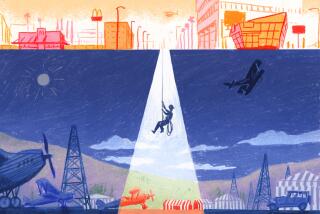They call it “the city of trees...
- Share via
They call it “the city of trees and PhDs,” and since Claremont was founded in 1887, the trees have gotten bigger and the PhDs more numerous.
Its original image was “Claremont the Beautiful,” so touted by promoters who designated it one of the Southland’s 30 communities planned along the Santa Fe railroad route.
But when the real estate boom went bust shortly after Claremont’s founding, its sole hotel was sold to Pomona College, which moved north from temporary quarters in its namesake city.
Thus began the “company town” nature of Claremont: a private, highly regarded collegiate conglomerate of Pomona, Scripps, Claremont McKenna, Harvey Mudd, Pitzer and Claremont Graduate School in rural tranquillity near the county’s eastern border, in the shadow of Mt. Baldy.
The locale is so congenial, in spite of high smog levels, that for many Claremont Colleges graduates, attending a class reunion doesn’t require much more than a short drive--they never move away.
Many who came to attend college or to teach stayed on, taking pleasure in helping to maintain its small, college town character. Alumni are often among the elected and appointed officials of the leafy, shady city that is more hamlet than metropolis.
Some of that civic involvement is the legacy of Claremont’s founders, a group of Congregationalist educators who, lured by the railroad’s campaign, came to the fledging town from New England in 1888 and shaped its character.
Transplanted professors and ministers missed the lush New England landscape, and set about planting trees and naming streets Yale, Harvard, Dartmouth, Columbia and Amherst.
The Congregationalists left other legacies in Claremont too. Temperance was an important issue for the town’s settlers, and the civic dislike of alcohol persisted for decades. Claremont did not have a liquor store until the 1960s, and liquor was not served by the glass until a pub opened in Claremont Village in 1979.
Most pre-1950s commercial growth was south of the colleges. The post-war suburban boom meant growth north, into the foothills, dividing Claremont into “old” and “new.”
The six colleges and the adjoining business district called the Village form the heart of town. The homes of Old Claremont surround the Village and lie west of the Claremont Colleges. A city-protected historical district includes Craftsman bungalows and Victorian houses dating from the 1890s.
In the late 1980s, 100 tract homes were built on the last level space available. Long ago, the city and scientists from the colleges had examined the foothills for unique vegetation and ecological value and decided to protect a few thousand acres of steep slope. Today, this city-owned area is known as Claremont Hills Wilderness Park.
(BEGIN TEXT OF INFOBOX / INFOGRAPHIC)
By The Numbers
City Business
Incorporated: Oct.3, 1907
Area in square miles: 13
Number of parks: 18
Ciy employees: 147
1995-96 budget: $10 million
*
People
Population: 32,503
Households: 10,466
Average household size: 3
Median age: 34
*
Ethnic Breakdown
Asian: 8%
Black: 5%
Other: 1%
Latino: 10%
White: 76%
*
Money and Work
Median household income: $53,588
Median household income / L.A. County: $34,965
Median home value: $251,800
Employed workers (16 and older): 17,381
Percentage of women employed: 59%
Percentage of men employed: 73%
Self-employed: 1,473
Carpoolers: 1,515
*
Retail Stores
Number of stores: 246
Number of employees: 1,955
Annual sales: $180 million
*
Families:
Married couples with children: 29%
Married couples with no children: 34%
Non-family households: 27%
Other types of families: 10%
Source: Claritas Inc. Household expenses are averages for 1994. All other figures are for 1990. Percentages have been rounded to the nearest whole number.
More to Read
Sign up for Essential California
The most important California stories and recommendations in your inbox every morning.
You may occasionally receive promotional content from the Los Angeles Times.










